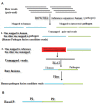Identification of Pathogen Signatures in Prostate Cancer Using RNA-seq
- PMID: 26053031
- PMCID: PMC4460021
- DOI: 10.1371/journal.pone.0128955
Identification of Pathogen Signatures in Prostate Cancer Using RNA-seq
Abstract
Infections of the prostate by bacteria, human papillomaviruses, polyomaviruses, xenotropic murine leukemia virus (MLV)-related gammaretroviruses, human cytomegaloviruses and other members of the herpesvirus family have been widely researched. However, many studies have yielded conflicting and controversial results. In this study, we systematically investigated the transcriptomes of human prostate samples for the unique genomic signatures of these pathogens using RNA-seq data from both western and Chinese patients. Human and nonhuman RNA-seq reads were mapped onto human and pathogen reference genomes respectively using alignment tools Bowtie and BLAT. Pathogen infections and integrations were analyzed in adherence with the standards from published studies. Among the nine pathogens (Propionibacterium acnes, HPV, HCMV, XMRV, BKV, JCV, SV40, EBV, and HBV) we analyzed, Propionibacterium acnes genes were detected in all prostate tumor samples and all adjacent samples, but not in prostate samples from healthy individuals. SV40, HCMV, EBV and low-risk HPVs transcripts were detected in one tumor sample and two adjacent samples from Chinese prostate cancer patients, but not in any samples of western prostate cancer patients; XMRV, BKV and JCV sequences were not identified in our work; HBV, as a negative control, was absent from any samples. Moreover, no pathogen integration was identified in our study. While further validation is required, our analysis provides evidence of Propionibacterium acnes infections in human prostate tumors. Noted differences in viral infections across ethnicity remain to be confirmed with other large prostate cancer data sets. The effects of bacterial and viral infections and their contributions to prostate cancer pathogenesis will require continuous research on associated pathogens.
Conflict of interest statement
Figures
Similar articles
-
Identification of viral infections in the prostate and evaluation of their association with cancer.BMC Cancer. 2010 Jun 24;10:326. doi: 10.1186/1471-2407-10-326. BMC Cancer. 2010. PMID: 20576103 Free PMC article.
-
A molecular analysis of prokaryotic and viral DNA sequences in prostate tissue from patients with prostate cancer indicates the presence of multiple and diverse microorganisms.Prostate. 2008 Feb 15;68(3):306-20. doi: 10.1002/pros.20680. Prostate. 2008. PMID: 18163428
-
Association between the presence of bacterial 16S RNA in prostate specimens taken during transurethral resection of prostate and subsequent risk of prostate cancer (Sweden).Cancer Causes Control. 2006 Nov;17(9):1127-33. doi: 10.1007/s10552-006-0054-2. Cancer Causes Control. 2006. PMID: 17006718
-
Evidence and controversies on the role of XMRV in prostate cancer and chronic fatigue syndrome.Rev Med Virol. 2011 Jan;21(1):3-17. doi: 10.1002/rmv.673. Epub 2010 Nov 26. Rev Med Virol. 2011. PMID: 21294212 Review.
-
Distribution of xenotropic murine leukemia virus-related virus (XMRV) infection in chronic fatigue syndrome and prostate cancer.AIDS Rev. 2010 Jul-Sep;12(3):149-52. AIDS Rev. 2010. PMID: 20842203 Review.
Cited by
-
Possibilities and limitations of using low biomass samples for urologic disease and microbiome research.Prostate Int. 2022 Dec;10(4):169-180. doi: 10.1016/j.prnil.2022.10.001. Epub 2022 Oct 7. Prostate Int. 2022. PMID: 36570648 Free PMC article. Review.
-
Differential Microbial Signature Associated With Benign Prostatic Hyperplasia and Prostate Cancer.Front Cell Infect Microbiol. 2022 Jul 5;12:894777. doi: 10.3389/fcimb.2022.894777. eCollection 2022. Front Cell Infect Microbiol. 2022. PMID: 35865814 Free PMC article.
-
Collateral damage: insights into bacterial mechanisms that predispose host cells to cancer.Nat Rev Microbiol. 2017 Feb;15(2):109-128. doi: 10.1038/nrmicro.2016.171. Epub 2017 Jan 3. Nat Rev Microbiol. 2017. PMID: 28045107 Review.
-
Evidence for a causal role by human papillomaviruses in prostate cancer - a systematic review.Infect Agent Cancer. 2020 Jul 14;15:41. doi: 10.1186/s13027-020-00305-8. eCollection 2020. Infect Agent Cancer. 2020. PMID: 32684946 Free PMC article. Review.
-
The Microbiome and Prostate Cancer Risk.Curr Urol Rep. 2019 Sep 7;20(10):66. doi: 10.1007/s11934-019-0922-4. Curr Urol Rep. 2019. PMID: 31493090 Review.
References
Publication types
MeSH terms
Substances
Grants and funding
LinkOut - more resources
Full Text Sources
Other Literature Sources
Medical
Research Materials


